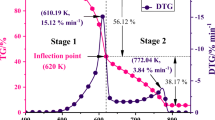Abstract
Pyrolysis kinetics analysis of extractives, holocellulose, and lignin in the solid redwood over the entire heating regime was possible by specialized cone calorimeter test and new mathematical analysis tools. Added hardware components include: modified sample holder for the thin specimen with tiny thermocouples, the methane ring burner with stainless-steel mesh above cone heater, and the water vapor sensor in heated gas sampling lines. Specialized numerical deconvolutions were applied to the oxygen and water vapor analyzer signals to synchronize with the rapid-responding CO/CO2 analyzer signals. From this data, the mass flow rates of carbon, hydrogen, and oxygen within the wood volatiles as function of time were obtained, which allowed deducing the mass flow rate of significant molecules of wood volatiles that have their origins in the wood constituents of extractives, holocellulose, and lignin. Accurate analytical solution of pyrolysis kinetics of appropriate competitive reactions that continuously conserved carbon, hydrogen, and oxygen mass flow rates was obtained for piecewise exponentially-shaped, spatially uniform temperature within the specimen as implemented conveniently in MS Excel spreadsheet.





Similar content being viewed by others
Abbreviations
- \( A_{{}} \) :
-
Arrhenius pre-exponential term, s−1
- \( a_{\text{k}} \) :
-
Pre-exponential coefficient in Eq. 19, K
- \( b_{\text{k}} \) :
-
Exponential coefficient in Eq. 19, s−1
- \( \beta \) :
-
Combustion product mass to oxygen depletion mass ratio
- \( E_{{}} \) :
-
Activation energy, kJ kmol−1
- \( f \) :
-
Molar fraction for competitive processes
- \( h_{\text{c,st}} \) :
-
Heat of combustion (stoichiometric), kJ g−1
- \( {\text{HRR}} \) :
-
Heat release flux, kW m−2
- \( I \) :
-
Integral term defined in Eq. 18, s
- \( \dot{m}^{\prime\prime}_{{}} \) :
-
Mass flux, g s−1 m2
- \( R \) :
-
Gas constant, kJ kmol−1 K−1
- \( S_{i} (t_{j} ) \) :
-
Typical signal data for data processing in Eq. 2
- \( t \) :
-
Time, s
- \( \tau_{i} \) :
-
Time constant in Eq. 2, s
- \( T \) :
-
Temperature, K
- \( U \) :
-
Number of nitrogen atoms in fuel empirical formula
- \( V \) :
-
Number of sulfur atoms in fuel empirical formula
- \( W \) :
-
Number of hydrogen atoms in total hydrocarbons of combustion
- \( X \) :
-
Number of carbon atoms in fuel empirical formula
- \( Y \) :
-
Number of hydrogen atoms in fuel empirical formula
- \( Z \) :
-
Number of oxygen atoms in fuel empirical formula
- \( \dot{z} \) :
-
Molar mass rate, s−1
References
Tang W. Effect of inorganic salts on the pyrolysis, ignition, and combustion of wood, cellulose, and lignin. Ph.D. thesis, chemical engineering, Madison: University of Wisconsin–Madison; 1964.
Parker W, LeVan S. Kinetic properties of the components of Douglas-Fir and heat of combustion. Wood Fiber Sci. 1989;21(3):289–305.
Hagge M, Bryden K, Dietenberger M. Effect of backing board materials on wood combustion performance. In: Proc. Wood & Fire Safety, 5th Int. Scientific Conference. Slovakia: Technical Univ. of Zvolen; April, 2004.
Shafizadeh F. The chemistry of pyrolysis and combustion. In: Rowell R, editor. The chemistry of solid wood, advances in chemistry series-207. Washington, D.C.: American Chemical Society; 1984. p. 13/489–529.
Muller-Hagedorn M, Bockhorn H, Krebs L, Muller U. A Comparative Kinetic Study on the Pyrolysis of Three Different Wood Species. J Anal Appl Pyrolysis. 2003;68–69:231–49.
Avni E, Davaudsadeh F, Couglin R. Flash Pyrolysis of Lignin. In: Overend Milne, Mudge, editors. Fundamentals of Biomass Thermochemical Conversion. London: Elsevier; 1985. p. 329–43.
McGraw G, Hemingway R, Ingram L, Canady C, Mcgraw W. Thermal degradation of terpenes: camphene, a-carene, limonene, and a-terpinene. Environ Sci Technol. 1999;33:4029–33.
Wooten JB, Seeman JI, Hajaligol MR. Observation and characterization of cellulose pyrolysis intermediates by 13C CPMAS NMR, a new mechanistic model. Energy Fuel. 2004;18(1):1–15.
Dietenberger M. Update for combustion properties of wood components. Fire Mater J. 2002;26:255–67.
Boroson M, Howard J, Longwell J, Peters W. Product yields and kinetics from the vapor phase cracking of wood pyrolysis tars. AIChE J. 1989;35(1):120–8.
Dietenberger M. Effect of backing board on the heat release rate of wood. In: Hilado C, editor. In: Proc. Intl. Conf. on Fire Safety. Columbus; July 1999.
De Groot W, Richards G. Gasification of cellulosic chars in oxygen and in nitrogen oxides. Carbon. 1991;29(2):179–83.
Chen CL. Occurrence in woody tissues, isolation, reactions, and structure. In: Lewin Goldstein, editor. Wood Structure and Composition. New York: Marcel Dekker, Inc; 1991. p. 183–261.
Pettersen R. The chemical composition of wood. In: Rowell R, editor. The chemistry of solid wood, advances in chemistry series -207. Washington, D.C.: American Chemical Society; 1984. p. 2/57–126.
Lewellen P, Peters W, Howard J. Cellulose pyrolysis kinetics and char formation mechanism. 16th Sym. On Combustion; August 1976. p.1471–1480.
Drews M, Barker R. Pyrolysis and combustion of cellulose part VI. The chemical nature of the char. In: Hilado C, editor. Pyrolysis of polymers, Vol. 13, fire and flammability series. Lancaster: Technomic Publishing; 1974. p. 21–29.
Kollmann F, Topf P. Exothermic reactions of wood at elevated temperatures. In: Hilado C, editor. Pyrolysis of polymers, vol. 13, fire and flammability series. Lancaster: Technomic Publishing; 1974. p. 43–51.
Author information
Authors and Affiliations
Corresponding author
Additional information
This article was written and prepared by the US government employees on official time, and it is therefore in the public domain and not subjected to copyright.
Rights and permissions
About this article
Cite this article
Dietenberger, M. Pyrolysis kinetics and combustion of thin wood by an advanced cone calorimetry test method. J Therm Anal Calorim 109, 1215–1228 (2012). https://doi.org/10.1007/s10973-012-2474-4
Published:
Issue Date:
DOI: https://doi.org/10.1007/s10973-012-2474-4




